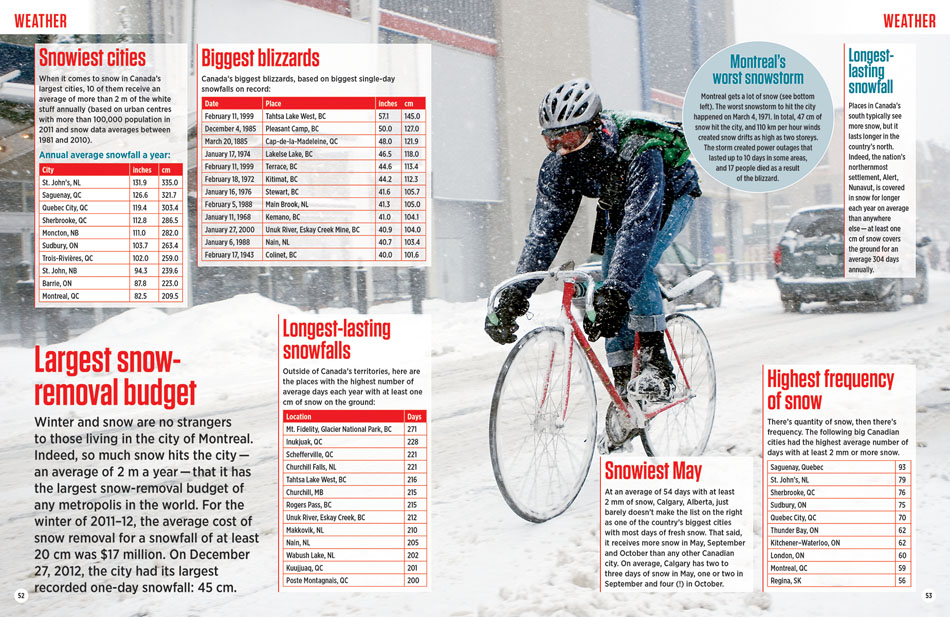| ________________
CM . . .
. Volume XXI Number 24 . . . . February 27, 2015
excerpt:
The book is organized into 11 thematic chapters: geography, weather, wildlife, structures/communities, business/industry, communications, innovations, transportation, pop culture, sports & leisure, and, people, places & things. At 34 pages, the chapter on geography is the longest, while communications consists of only 10 pages. The last two pages of the chapter on structures/communities clearly belong with the business/industry section that follows. The number of errors uncovered is small given the amount of facts reported. There are a couple of inconsistent spellings of names (harbor/harbour seal, Macassa/Mancassa gold mine), and an error of omission in the list of Canadian Nobel prize winners as John Polanyi (co-winner with two others in 1986 for chemistry) is absent, and Banting’s co-winner J.B. Collip should be named in the list. Alice Munro is noted in the introductory paragraph but should have been included in the numbered list of Nobel laureates. Like The Guinness Book of World Records, this volume is intended to appeal to readers of virtually every age. They will likely want to dip into the book rather than read it cover to cover. It can be a great starting place for school research assignments. The chapter on innovations, for example, can be used to begin additional research on inventors and the products under discussion. The necessarily brief entries may send a reader to the Internet to look up a named place on a map or to find a picture of a named animal species. Caution is in order, however, since a side trip to the Internet can readily end up far removed from the book in hand. Canadian Geographic Biggest and Best of Canada includes tidbits from all parts of the country. Given the wide variety of topics covered, there should be something of interest to just about everyone. Kylie tries to avoid controversy by largely ignoring the sphere of politics and by presenting facts in a nonjudgmental way:
The scope of superlatives presented is truly amazing, including: best, deepest, fastest, longest, biggest, first, highest, worst, calmest, deadliest, wettest, rainiest, coldest, northernmost, snowiest, fewest, foggiest, driest, windiest, smallest, tallest, greenest, busiest, southernmost, easternmost, westernmost, oldest, earliest, slowest growing, sunniest, hottest, least, most, youngest, worst and last. The inclusion of an extensive list of roadside attractions, a subcategory of people, places & things, is a welcome component. The index wisely omits superlatives, focussing on names and topics, often with sublistings such as eight different species under the heading for birds and seven institutions under museums. The index is good, but not exhaustive, and adds to the use of the book for reference purposes. The informal writing style will appeal to young readers. Some distinctions are wanting. For example, what is the highest point of land in a province as distinct from, say, the highest mountain peak in the same jurisdiction? Overall, this volume has great potential for reluctant readers who may find the colourful graphics and short text blocks manageable. It will satisfy the curious, trivia nuts and anyone who wants to learn more about the amazing land and people of Canada. Costing only 10 cents per page, Canadian Geographic Biggest and Best of Canada is an affordable addition to school and public libraries and will make a nice gift for a young person, a new Canadian, or a Canadian-born citizen. Recommended. Val Ken Lem is a collections librarian at Toronto’s Ryerson University and a life-long student of all things Canadian.
To comment on this title or this review, send mail to cm@umanitoba.ca.
Copyright © the Manitoba Library Association. Reproduction for personal use is permitted only if this copyright notice is maintained. Any
other reproduction is prohibited without permission.
CM Home | Next Review | Table of Contents for This Issue - February 27, 2015 | Back Issues | Search | CM Archive | Profiles Archive |
 Canadian Geographic magazine and Firefly Books are well known for their stunning photographs, and so it is no surprise that this volume by the editor of Canadian Geographic includes wonderful visuals. A typical two-page spread contains one massive photograph that corresponds to a factual paragraph that is set in the largest type font on the page. The necessity of adding four to thirteen additional text blocks and perhaps one or several smaller visuals to the spread diminishes the full impact of the background image.
Canadian Geographic magazine and Firefly Books are well known for their stunning photographs, and so it is no surprise that this volume by the editor of Canadian Geographic includes wonderful visuals. A typical two-page spread contains one massive photograph that corresponds to a factual paragraph that is set in the largest type font on the page. The necessity of adding four to thirteen additional text blocks and perhaps one or several smaller visuals to the spread diminishes the full impact of the background image.